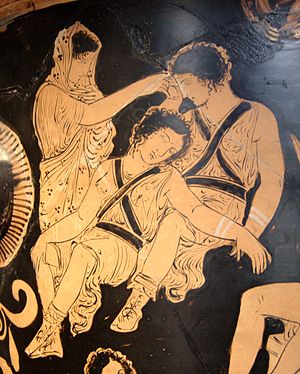Ἐρινύες
Ἀνὴρ ἀτυχῶν δὲ σώζεται ταῖς ἐλπίσιν → Presso miseria spes salus est unica → Allein die Hoffnung trägt den, der im Unglück ist
Wikipedia EN
In ancient Greek religion and mythology, the Erinyes (/ɪˈrɪniˌiːz/; sing. Erinys /ɪˈrɪnɪs/, /ɪˈraɪnɪs/; Greek: Ἐρινύες, pl. of Ἐρινύς, Erinys), also known as the Furies, were female chthonic deities of vengeance, sometimes referred to as "infernal goddesses" (χθόνιαι θεαί). A formulaic oath in the Iliad invokes them as "the Erinyes, that under earth take vengeance on men, whosoever hath sworn a false oath." Walter Burkert suggests they are "an embodiment of the act of self-cursing contained in the oath." They correspond to the Dirae in Roman mythology. The Roman writer Maurus Servius Honoratus wrote that they are called "Eumenides" in hell, "Furiae" on earth, and "Dirae" in heaven.
According to Hesiod's Theogony, when the Titan Cronus castrated his father, Uranus, and threw his genitalia into the sea, the Erinyes (along with the Giants and the Meliae) emerged from the drops of blood which fell on the earth (Gaia), while Aphrodite was born from the crests of sea foam. According to variant accounts, they emerged from an even more primordial level—from Nyx ("Night"), or from a union between air and mother earth. Their number is usually left indeterminate. Virgil, probably working from an Alexandrian source, recognized three: Alecto or Alekto ("endless"), Megaera ("jealous rage"), and Tisiphone or Tilphousia ("vengeful destruction"), all of whom appear in the Aeneid. Dante Alighieri followed Virgil in depicting the same three-character triptych of Erinyes; in Canto IX of the Inferno they confront the poets at the gates of the city of Dis. Whilst the Erinyes were usually described as three maiden goddesses, the Erinys Telphousia was usually a by-name for the wrathful goddess Demeter, who was worshipped under the title of Erinys in the Arkadian town of Thelpousa.
Wikipedia EL
Οι Ερινύες στην ελληνική μυθολογία ήταν μυθικές χθόνιες θεότητες που κυνηγούσαν όσους είχαν διαπράξει εγκλήματα κατά της φυσικής και ηθικής τάξης των πραγμάτων. Επίσης είναι γνωστές και ως Ευμενίδες, δίνοντας έτσι το όνομά τους στην τρίτη τραγωδία της τριλογίας Oρέστεια του Αισχύλου. Στη συγκεκριμένη τραγωδία κατατρέχουν τον Ορέστη, γιο του Αγαμέμνονα και της Κλυταιμνήστρας, για τον φόνο της μητέρας του.
Wikipedia DE
Die Erinnyen oder Erinyen (altgriechisch Ἐρινύες, in der Einzahl Ἐρινύς Erinys; lateinisch Erinys, Erinnys) – bei den Griechen auch als Μανίαι Maniai, „die Rasenden“, später als Eumeniden (Εὐμενίδες), bei den Römern als Furien (furiae) bezeichnet – sind in der griechischen Mythologie drei Rachegöttinnen
Wikipedia FR
Dans la mythologie grecque, les Érinyes ou Érinnyes (en grec ancien Ἐρινύες / Erinúes), ou parfois « déesses infernales » (χθόνιαι θεαί / khthóniai theaí), sont des divinités persécutrices. Selon Eschyle, elles sont transformées en σεμναὶ / semnaì, « vénérables », après l'acquittement d'Oreste, occasion à laquelle Athéna aurait obtenu d'elles qu'elles devinssent des divinités protectrices d'Athènes sous le rôle de gardiennes de la justice. Euripide les a identifiées avec les Euménides (grec Εὐμενίδες / Eumenídes, « les Bienveillantes ») Elles correspondent aux Furies chez les Romains.
Wikipedia ES
In la mitología griega, las Erinias (en griego antiguo Έρινύες Erinýes, de etimología desconocida) son personificaciones femeninas de la venganza que perseguían a los culpables de ciertos crímenes. También se las llamaba Euménides (en griego antiguo Εύμενίδες, ‘benévolas’), antífrasis utilizada para evitar su ira cuando se pronunciaba su verdadero nombre. Según la tradición, este nombre se habría empleado por primera vez tras la absolución de Orestes por el Areópago (descrita más adelante), y más tarde se usó para aludir al lado benigno de las Erinias.
En Atenas también se utilizaba eufemísticamente la perífrasis σεμναί θεαί semnaí theaí, ‘venerables diosas’. Asimismo se aludía a ellas como χθόνιαι θεαί chthóniai theaí, ‘diosas ctónicas’, y se les aplicaba el epíteto Praxídiceas (Πραξιδίκαι), ‘ejecutoras de las leyes’. En la mitología romana se les conoce como Furias (en latín Furiæ o Diræ, ‘terribles’).
Es posible que ya estuvieran documentadas en las tablillas micénicas de lineal B bajo la forma del teónimo E-ri-nu.
Wikipedia IT
Le Erinni (in greco: Ερινύες) sono, nella religione e nella mitologia greca, le personificazioni femminili della vendetta (Furie nella mitologia romana) soprattutto nei confronti di chi colpisce la propria famiglia e i parenti.
Translations
af: Eriniër; ar: إيرينيس; az: Erinilər; bar: Erinnyen; bg: Еринии; bn: ইরিনিস; br: Erinied; bs: Erinije; ca: Eumènides; cs: Erínye; da: Erinye; de: Erinnyen; el: Ερινύες, Ευμενίδες; grc: Ἐρινύες, Εὐμενίδες; en: Erinyes, Eumenides, Furies; eo: Erinioj; es: Erinias; et: Erinnüsed; eu: Eriniak; fa: الهههای انتقام; fi: Erinykset; fr: Érinyes; gl: Erinias; he: אריניה; hr: Erinije; hu: Erinnüszök; hy: Էրինիաներ; id: Erinyes; io: Erinii; it: Erinni; ja: エリーニュス; ka: ერინიები; ko: 에리니에스; la: Furiae; lb: Erinyen; lt: Erinijos; lv: Erīnijas; mk: Еринии; nl: Erinyen; nn: Erinnyer; no: Erinyer; pl: Erynie; pt: Erínias; ro: Furii; ru: Эринии; sh: Erinije; simple: Erinyes; sk: Erínye; sl: Erinije; sq: Eriniet; sr: Ериније; sv: Erinyer; tl: Erinyes; tr: Erinyeler; uk: Еринії; vi: Erinyes; wuu: 厄里倪厄斯; zh_yue: 厄里倪厄斯; zh: 厄里倪厄斯

